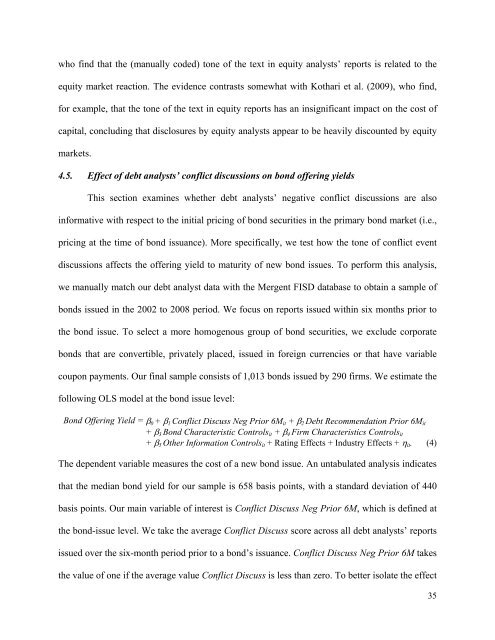Debt Analysts' Views of Debt-Equity Conflicts of Interest
Debt Analysts' Views of Debt-Equity Conflicts of Interest
Debt Analysts' Views of Debt-Equity Conflicts of Interest
Create successful ePaper yourself
Turn your PDF publications into a flip-book with our unique Google optimized e-Paper software.
who find that the (manually coded) tone <strong>of</strong> the text in equity analysts’ reports is related to the<br />
equity market reaction. The evidence contrasts somewhat with Kothari et al. (2009), who find,<br />
for example, that the tone <strong>of</strong> the text in equity reports has an insignificant impact on the cost <strong>of</strong><br />
capital, concluding that disclosures by equity analysts appear to be heavily discounted by equity<br />
markets.<br />
4.5. Effect <strong>of</strong> debt analysts’ conflict discussions on bond <strong>of</strong>fering yields<br />
This section examines whether debt analysts’ negative conflict discussions are also<br />
informative with respect to the initial pricing <strong>of</strong> bond securities in the primary bond market (i.e.,<br />
pricing at the time <strong>of</strong> bond issuance). More specifically, we test how the tone <strong>of</strong> conflict event<br />
discussions affects the <strong>of</strong>fering yield to maturity <strong>of</strong> new bond issues. To perform this analysis,<br />
we manually match our debt analyst data with the Mergent FISD database to obtain a sample <strong>of</strong><br />
bonds issued in the 2002 to 2008 period. We focus on reports issued within six months prior to<br />
the bond issue. To select a more homogenous group <strong>of</strong> bond securities, we exclude corporate<br />
bonds that are convertible, privately placed, issued in foreign currencies or that have variable<br />
coupon payments. Our final sample consists <strong>of</strong> 1,013 bonds issued by 290 firms. We estimate the<br />
following OLS model at the bond issue level:<br />
Bond Offering Yield = 0 + 1 Conflict Discuss Neg Prior 6Mit + 2 <strong>Debt</strong> Recommendation Prior 6Mit<br />
+ 3 Bond Characteristic Controlsit + 4 Firm Characteristics Controlsit<br />
+ 5 Other Information Controlsit + Rating Effects + Industry Effects + it. (4)<br />
The dependent variable measures the cost <strong>of</strong> a new bond issue. An untabulated analysis indicates<br />
that the median bond yield for our sample is 658 basis points, with a standard deviation <strong>of</strong> 440<br />
basis points. Our main variable <strong>of</strong> interest is Conflict Discuss Neg Prior 6M, which is defined at<br />
the bond-issue level. We take the average Conflict Discuss score across all debt analysts’ reports<br />
issued over the six-month period prior to a bond’s issuance. Conflict Discuss Neg Prior 6M takes<br />
the value <strong>of</strong> one if the average value Conflict Discuss is less than zero. To better isolate the effect<br />
35
















